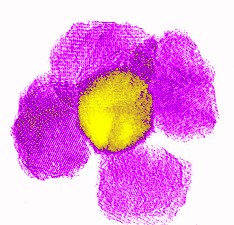Chemistry, physics, and materials scientists at Pennsylvania State University have invented a new system using magnetism to purify hybrid nanoparticles, a development with implications for drug delivery, medical imaging, and related fields. The findings of Mary Elizabeth Williams, Raymond E. Schaak, and their colleagues at Penn State appear online in the journal Agewandte Chemie (paid subscription required).
Hybrid nanoparticles are composed of two or more kinds of materials in nanoscale — one nanometer equals one billionth of a meter — that are visible only with an electron microscope. Purifying hybrid nanoparticles is particularly important when nanoparticles are designed for medical use, as in the delivery of drugs or as an alternative to contrast dyes for patients undergoing MRI scans.
The technique devised by the Penn State team in this study funded by the National Science Foundation uses the magnetic components of nanoparticles to tell them apart and to separate impurities from the target nanoparticle structures. In the technique, magnetic fields slow the flow of particles through tiny glass tubes called capillaries.
A magnet pulls magnetic particles against the wall of the tube and, when the magnetic field is reduced, the particles flow out of the capillary. As Williams explains, “Magnetism increases as particle volume increases, so small and gradual changes in the magnetic field let us slowly separate and distinguish between nanoparticles based on even minute magnetic and structural differences.”
In one example of this technique, the researchers separated “nano-flowers” (pictured at top), with a petal-like arrangement of odd-shaped iron oxide particles around a core of spherically shaped gold particles. Williams says the magnetism of the particles depends on their shape, so particles of a different shape adhere to the capillary wall when different magnetic fields are applied, thus allowing the researchers to distinguish between the different particles.
Another example involved all spherical nanoparticles, with basically the same shape, and composed of an inner core of one material and an outer core of another, much like an olive with a pimento in the center. These “nano-olives” — made of iron, platinum, and oxygen — have slightly different internal compositions that are impossible to detect under a microscope.
As Schaak notes, the magnetic technique enabled the team to filter out the nano-olives with more iron content. “They stick along the walls of the capillary tubes more easily,” says Schaak, “while more magnetically weak particles flow out.”
With greater purification, nanoparticles could be used in place of contrast dye when patients undergo MRI scans. The particles could be used to track where a drug is traveling in the human body, particularly when patients are allergic to contrast dyes. The purification techniques can also make drugs in the form of nanoparticles safer for delivery, or better focused against disease targets.
Read more: FDA Holding Workshop on Nanotech and Medical Devices
* * *


 RSS - Posts
RSS - Posts
You must be logged in to post a comment.